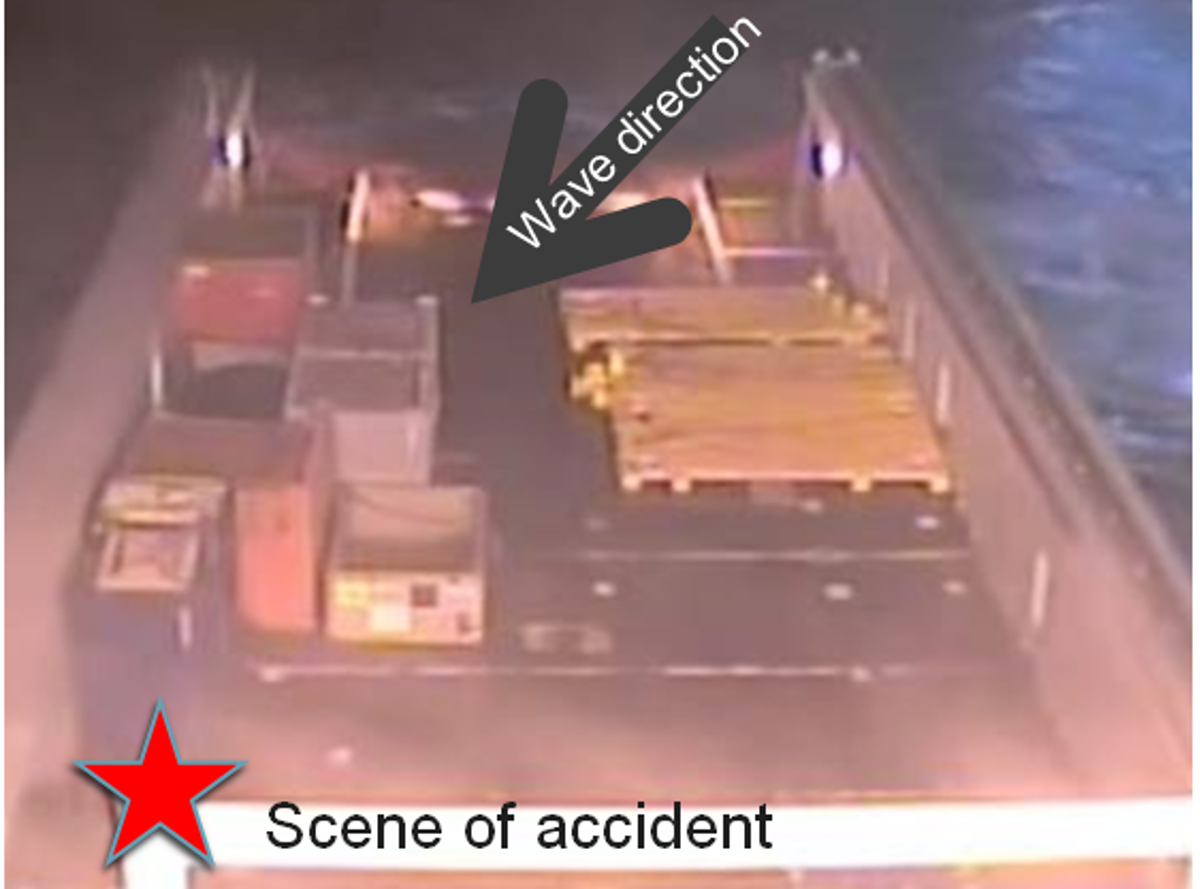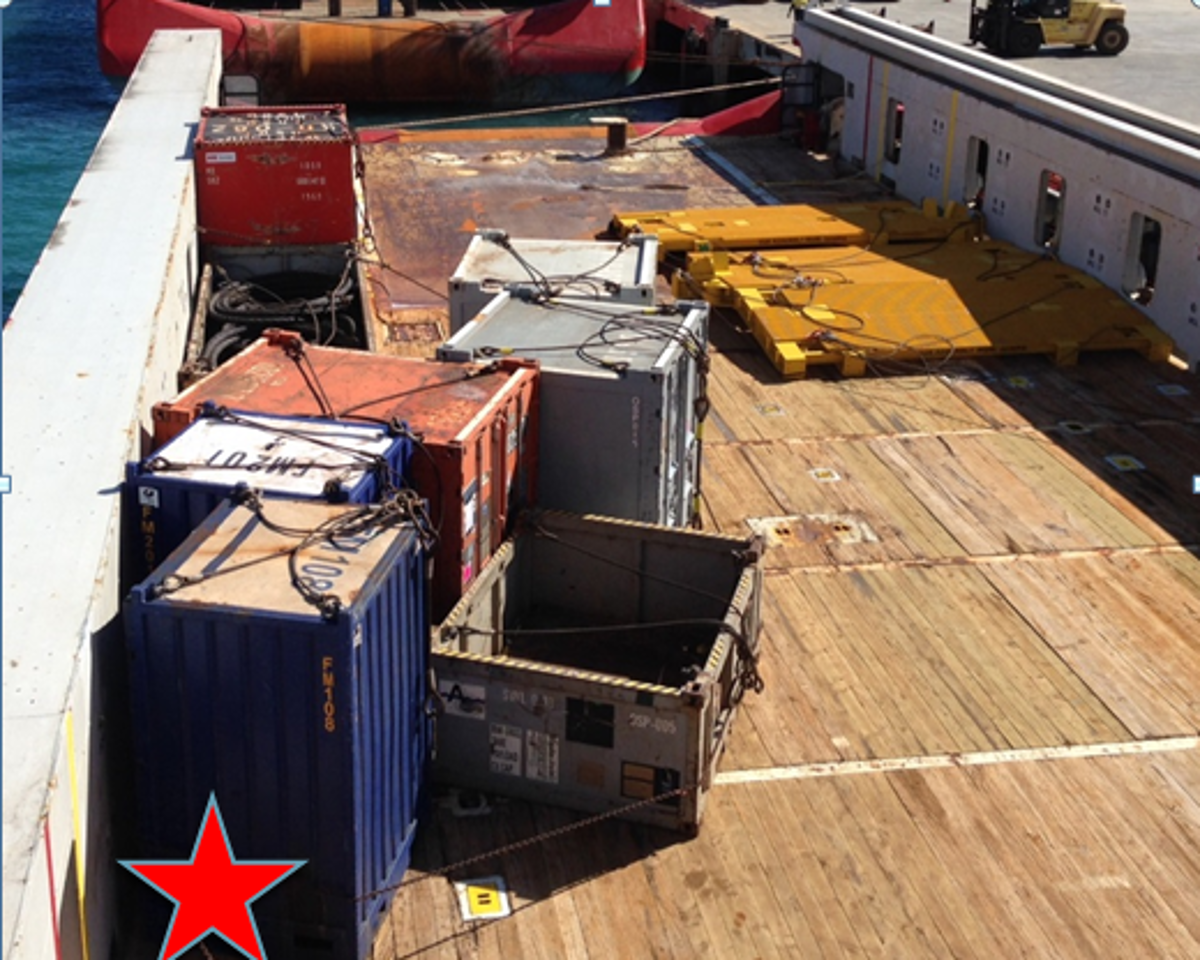Fatality during loading operations
- Safety Flash
- Published on 7 December 2015
- Generated on 25 April 2025
- IMCA SF 21/15
- 5 minute read
Jump to:
A Member has reported an incident in which a crew member was struck and fatally injured by a mini-container whilst working on back-loaded cargo from a drilling rig.
What happened?
A Member has reported an incident in which a crew member was struck and fatally injured by a mini-container whilst working on back-loaded cargo from a drilling rig. The incident occurred when heavy seas struck the vessel causing sudden movement of landed cargo, upon which the crew were still working to make it fully secure. The movement of this cargo resulted in a crew member being trapped between a mini container and a skip bin. The vessel crew responded to the injured person, releasing him from between the mini container and the skip, and administering first aid and CPR. He was further attended to by a medic who was transferred from the drilling rig. The injured person was transferred to the rig but could not be revived.
The vessel had been alongside the rig for a number of hours during the night, during which time six loads had been transferred to the rig and nine loads (mostly empty containers) back-loaded from the rig. After four hours the weather had started to deteriorate. The chief officer of the vessel advised the drilling rig that the vessel would be ceasing cargo operations and that the drilling rig crew should stop any further loading. The vessel moved approximately 30m away from the rig (still sitting in the lee of the rig for additional shelter). Seas at the time were running between 2 m and 3 m and the wind was 24 knots, gusting to 36 knots.
During this time the deck crew continued work on securing the cargo. Two Able Seamen (ABs) working on the deck decided that the sea fastening arrangement was not adequate to restrain the two mini containers located at the forward end of the deck. Additional rigging was required to rectify this, and one of the ABs left the deck to go to the nearby rigging store. The tension on the tugger winch was released to facilitate installation of the new rigging. A large wave crashed over the back deck of the vessel and travelled along the length of the deck, with the force of the wave causing movement of some of the landed cargo. The movement of this cargo resulted in the ABs becoming trapped between a mini container and a skip bin, with fatal consequences.

plan view of vessel

photograph showing scene of incident

photograph showing scene of incident
What were the causes?
Our member’s investigation identified the following immediate causes:
- Working in and around unsecured cargo had become part of a familiar routine.
- A vessel with an open stern being used for cargo operations.
- Wave struck cargo.
- Cargo shifted 3-4 m on deck aft to forward.
- The crewman involved did not get out of the ‘line of fire’ or hear the bridge warning over UHF radio.
Our member’s investigation identified the following root causes:
- Vessel operations in the 500m rig zone are not recognised as Simultaneous Operations (SIMOPS) for the rig and vessel. There was no process in place to ensure effective communications, load sequencing, deck layout planning, cargo securing plans and optimising time of vessel alongside rig in Dynamic Positioning (DP) mode.
- The potential for injuries to crew undertaking cargo securing tasks offshore on Anchor Handling Tug Supply (AHTS) vessels (due to open stern) had not been identified as high risk.
- No risk assessment had been carried out for suitability of AHTS vessels performing cargo operations.
- The vessel procedure for cargo loading and unloading did not describe a cargo lashing plan, and although there was a risk assessment for cargo loading, there was no specific risk assessment for the work activities associated with the further securing of landed cargo.
Actions
Our member took the following actions, with a view to minimising the risks associated with cargo operations to As Low As Reasonably Practicable (ALARP):
- Further detailed risk assessment for AHTS conducting cargo operations. Risk assessment should include consideration of engineering controls to minimise excessive water on the vessel back deck (stern door or use of other vessel type).
- A review and update of company adverse weather working guidelines.
- A review of company cargo loading procedure to include cargo lashing arrangements, and further risk assessment for securing cargo.
- A review and update of company cargo securing procedure and risk assessment to include the requirement for a lashing plan and load sequence planning with rig before entering the 500m zone.
The Marine Safety Forum (MSF) has published a number of incidents in recent years drawing the attention of marine contractors to incidents during cargo operations. [These have all been passed to members as IMCA safety flashes, but the details will need to be sought from the MSF.] Brief details are set out here:
- Able seaman injured by shifting cargo – a crewman was injured by unstable cargo that shifted when the vessel rolled
- Securing of cargo – in which incorrectly stowed cargo toppled over due to the vessel’s motion on encountering unexpected adverse weather conditions. The equipment was incorrectly positioned during the outbound load out and was not secured
- Gangway safety: A review of recent incidents and near-misses involving vessel gangways – two crewmen narrowly escaped severe crush injuries whilst engaged in cargo back-loading operations alongside a platform. Owing to inadequate communications, a load was lifted and began to swing without warning to crew working on deck.
Related safety flashes
-
IMCA SF 09/13
18 June 2013
-
IMCA SF 07/13
9 May 2013
-
IMCA SF 11/12
26 October 2012
IMCA Safety Flashes summarise key safety matters and incidents, allowing lessons to be more easily learnt for the benefit of the entire offshore industry.
The effectiveness of the IMCA Safety Flash system depends on the industry sharing information and so avoiding repeat incidents. Incidents are classified according to IOGP's Life Saving Rules.
All information is anonymised or sanitised, as appropriate, and warnings for graphic content included where possible.
IMCA makes every effort to ensure both the accuracy and reliability of the information shared, but is not be liable for any guidance and/or recommendation and/or statement herein contained.
The information contained in this document does not fulfil or replace any individual's or Member's legal, regulatory or other duties or obligations in respect of their operations. Individuals and Members remain solely responsible for the safe, lawful and proper conduct of their operations.
Share your safety incidents with IMCA online. Sign-up to receive Safety Flashes straight to your email.